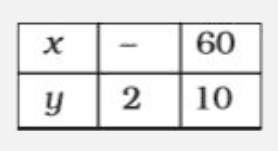If x varies as y, then which of the following is/are correct?
1. x2+y2 varies as x2−y2
2. xy2 varies inversely as y
3. n√x2y varies as 2n√x4y2
Select the correct answer using the code given below :
1 and 2 only
2 and 3 only
3 only
1, 2 and 3
To solve the problem, we need to analyze each statement given the condition that x varies as y. This means we can express x in terms of y as follows:
x=k⋅y
where k is a constant.
Now, let's evaluate each statement one by one.
Statement 1: x2+y2 varies as x2−y2
1. Substitute x=k⋅y into both expressions:
- x2=(k⋅y)2=k2y2
- Therefore, x2+y2=k2y2+y2=(k2+1)y2
- And x2−y2=k2y2−y2=(k2−1)y2
2. Now we can see that:
- x2+y2 varies as y2
- x2−y2 also varies as y2
3. The ratio of x2+y2 to x2−y2 is:
x2+y2x2−y2=(k2+1)y2(k2−1)y2=k2+1k2−1
This is a constant, meaning both expressions vary together.
Conclusion for Statement 1: True
Statement 2: xy2 varies inversely as y
1. Substitute x=k⋅y:
xy2=k⋅yy2=ky
2. This shows that xy2 varies inversely as y.
Conclusion for Statement 2: True
Statement 3: √(n)x2y varies as √(2n)x4y2
1. Substitute x=k⋅y:
- x2=k2y2
- Therefore, x2y=k2y2⋅y=k2y3
- Thus, √(n)x2y=√(n)k2y3=√(n)k2⋅y3/n
2. Now for √(2n)x4y2:
- x4=(k2y2)2=k4y4
- Therefore, x4y2=k4y4⋅y2=k4y6
- Thus, √(2n)x4y2=√(2n)k4⋅y6/(2n)=√(2n)k4⋅y3/n
3. Both expressions contain y3/n and differ only by constants:
- √(n)k2 and √(2n)k4 are constants.
Conclusion for Statement 3: True
Final Conclusion:
All three statements are true.
Summary of Steps:
1. Analyze the relationship between x and y using the proportionality condition.
2. Substitute x=k⋅y into each statement.
3. Simplify the expressions and check if they vary together or inversely.
4. Conclude the truth of each statement based on the analysis.
- x2=(k⋅y)2=k2y2
- Therefore, x2+y2=k2y2+y2=(k2+1)y2
- And x2−y2=k2y2−y2=(k2−1)y2
- x2+y2 varies as y2
- x2−y2 also varies as y2
x2+y2x2−y2=(k2+1)y2(k2−1)y2=k2+1k2−1
This is a constant, meaning both expressions vary together.
xy2=k⋅yy2=ky
- x2=k2y2
- Therefore, x2y=k2y2⋅y=k2y3
- Thus, √(n)x2y=√(n)k2y3=√(n)k2⋅y3/n
- x4=(k2y2)2=k4y4
- Therefore, x4y2=k4y4⋅y2=k4y6
- Thus, √(2n)x4y2=√(2n)k4⋅y6/(2n)=√(2n)k4⋅y3/n
- √(n)k2 and √(2n)k4 are constants.
All three statements are true.
1. Analyze the relationship between x and y using the proportionality condition.
2. Substitute x=k⋅y into each statement.
3. Simplify the expressions and check if they vary together or inversely.
4. Conclude the truth of each statement based on the analysis.
Similar Questions
Knowledge Check
Which of the following is correct in respect of the equations x−12=y−23 and 2x+3y=5 ?
AThey represent two lines which are parallel.BThey represent two lines which are perpendicular.CThey represent two lines which are neither parallel nor perpendicular.DThe first equation does not represent a line.Among the following equations, which are linear
1. 2x+y−z=5
2. πx+y−ez=log3
3. 3x+2y=7
4. sinx−y−5z=4
Select the correct answer using the code given belowA1 onlyB1 and 2 onlyC3 and 4D1, 2 and 4Consider the equation x+|y|=2y
Which of the following statements are not correct ?
1. y as a function of x is not defined for all real x.
2. y as a function of x is not continuous at x=0
3. y as a function of x is differentiable for all x.
Select the correct answer using the code given below :AA) 1 and 2BB) 2 and 3CC) 1 and 3DD) 1, 2 and 3
Let x and y be positive integers such that x is prime and y is composite. Which of the following statements are correct ?
1 (y-x) can be an even integer
2 xy can be an even integer
3 0.5 (x+y) can be an even integer
Select the correct answer using the code given below:
View SolutionIf x2 varies directly as y3 and when x=6, y=3, then which of the following relations s true?
(A) 3x2=4y3 (B) 3x2=2y3 (C)y2=2x3 (D) y3=2x2
View SolutionConsider the equation x+|y|=2y. Which of the following statements are not correct?I. y as a function of x is not defined for all real x.II. y as a function of x is not continuous at x=0.III. y as a function of x is differentiable for all x.Select the correct answer using the codes given below.
View SolutionIf x varies inversely as y and x = 20 when y = 600, find y when x = 400
View SolutionIf x varies inversely as y and when x = 6, y = 8, then for x = 8 the value of y is 10.
View Solution

